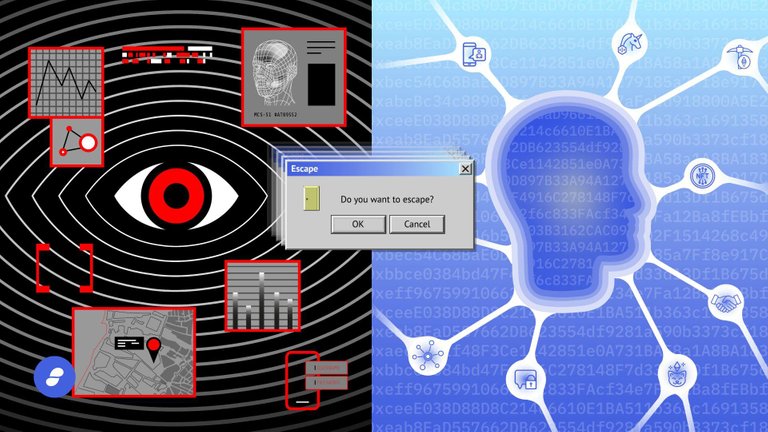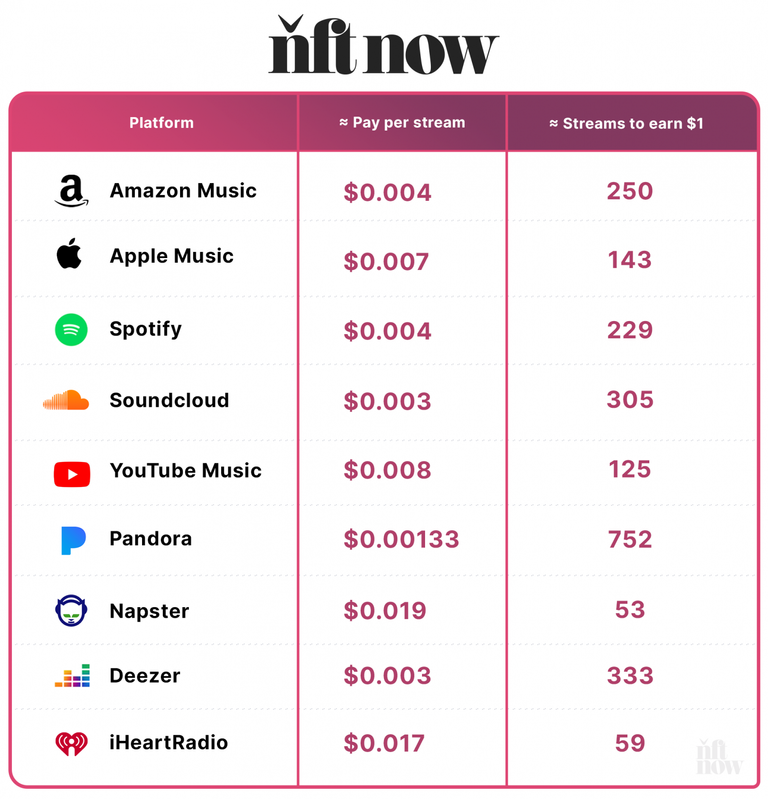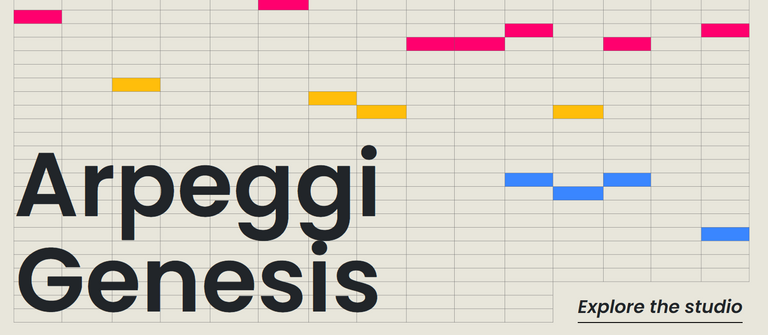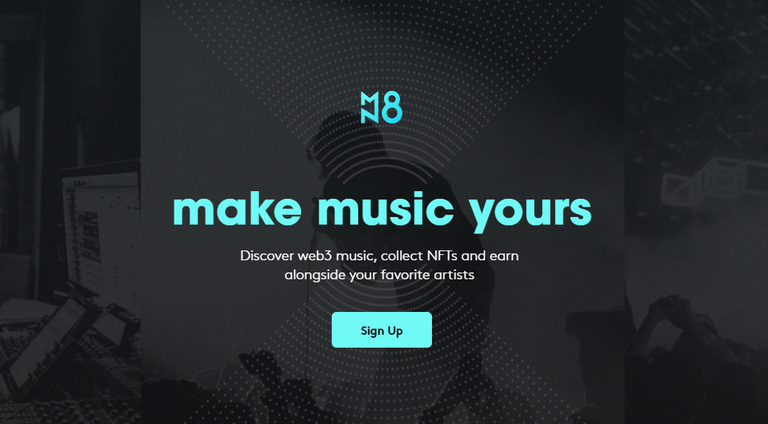[EN | ES ] An analysis of: Music Stage on the web3 | Un análisis de: Escenario Musical en la web3
Hello FOX!
Non-fungible tokens are an unrivaled tool for adding value to the markets. With NFTs, artists create autonomy from big technology, monetizing their work without relying on intermediaries. One of the expanding implications in 2022 is the usability of NFTs in the music business.
Version en español después de la versión en ingles 🦊
Let's learn a bit about web3 songs?
Reward creators and tokenized incentives

The music market is a sector that moves billions of dollars annually. Endowed with various nuances related to copyright, contracts and intermediaries, artists who intend to sell their art to interested parties find themselves immersed in a spiral of bureaucracy, centralization and low income.
Major music streaming platforms like Spotify, SoundCloud, and Apple Music return $43 billion in annual revenue. Revenue from the exploitation of music rights purchased by artists ranges 88% to companies, * while only 12% are directed at those responsible for creating the content.*

- For a musician to earn $1 on Spotify, he must stream her song 229 times. Source: nft now*
In this way, the musicians are harmed, obtaining little profit compared to the companies in charge of streaming. Dependence on platforms to monetize their work makes them give up profits to earn income capable of funding their next jobs.
But with web3, this scenario may be different.
The tokenization of music through NFT creates a unique model, unthinkable before the advent of non-fungible tokens. With blockchain, musicians can distribute their work without depending on intermediaries, receive royalties for each sale made and share with their fans, in real time, the profits obtained from their artistic creations. These features and many others rely solely on smart contract programming.
Blockchain allows the bridge between the artist and the consuming public to be only the necessary infrastructure to allow their consumption, without promoting a profitable intermediary or a high profit margin for centralized companies.
Through this new paradigm, independent artists manage to be rewarded with the use of web3. By abstracting the predatory costs and exploitation of the industry from profits, a more friendly and sustainable environment is created, promoting the development of art and the appreciation of the music scene.
Decentralization, once again, contributes to building a healthy and beneficial system for all.

The birth of this new world also offers the possibility for all users to keep their identities anonymous. Concern about the excessive data collection carried out by big techs has become latent among the world's population, with the fear that their personal information will be leaked.
In web3, decentralized applications or dapps do not require identification, only their wallets. bags are the new gateway to this new world. Furthermore, smart contracts automate transactions between creators and fans, excluding the risks of the range of intermediaries existing in the traditional market.
To help musicians enter this universe, marketplaces like Audius, Arpeggi and Emanar offer their interface to connect them with their fans.
We will show you the advantages of each of them and their differentials.
Audio

Audius was launched at the end of 2019. With an interface similar to Soundcloud, it emerges as a proposal to be a decentralized platform, built to empower musicians and help them in the distribution process. of their works, without charging a single cent on the income obtained from the creations.
In this way, the songs can be freely available to everyone.
Operating on the Ethereum and Solana blockchain, it acts as a broadcast protocol governed by token holders, AUDIO. Updates, tariff modifications, the inclusion of new features can be discussed and approved by the holders of AUDIO.
While AUDIO is the driving force behind their economy, tokenomics also involves other cryptocurrencies and stablecoins. Artists can create benefits available only to holders of their tokens, whether fungible or not, for example.
Musicians also receive additional rewards for being among the most played songs on stream, providing incentives for community building and fair pay for content creators.
Arpeggio Study

Arpeggi is the first platform that proposes to create chain music.
Similar to Artblocks and Fidenza, their founders' concern is that most NFTs are not stored on the blockchain, due to their inefficiency in storing large chunks of data. To get around this difficulty, they store images and music on centralized servers and insert only links to them in the tokens. It's a solution, but it fails with the ethos of decentralization.
Arpeggi allows you to store the songs created in your studio directly on the non-fungible token. With an extension of 256 bytes, the information is stored in NFT and represents a milestone for chain art. You can learn a bit more about this market here.

The project developed a digital audio workstation compatible with browsers such as Brave, Google Chrome and Firefox. Within the application, the artist can create a music track locally and edit it with the available tools, developing a unique art compatible with his style.
Using the Ethereum blockchain, it also allows creators to set royalties from on-chain sales of their music directly in the protocol, making it easy for them to receive percentages on secondary market sales of their works.
Emanate

Emanate is one of the main projects in the web3 music scene.
The platform provides a series of resources to artists and users that other projects have not yet implemented, such as the example of the compatibility and use of songs, carried out in Emanar, within metaverses. Additionally, producers also have guaranteed on-chain authorship records and can allow direct uploads.
His project has an economic model based on its main EMT token and also on the use of its own stablecoin. Using the EOS blockchain as infrastructure, artists can verify all broadcasts or sales of NFTs through network block explorers like Bloks.io and EOSX.io.
In this protocol, musicians have a range of options to monetize their work. By uploading to the platform, Emanate makes it possible to receive payments for every stream made by users, monthly income paid by fans who are members of Emanate Music Lovers or even use Emanate Distro as an interface to access web2 streaming .
According to its founders, its objective is to help independent artists obtain a profit compatible with the work necessary to materialize their creations. They know the difficulty of onboarding new people in the web3 and bringing functionalities to facilitate the entry of users in this universe.
In addition to these projects, there are other protocols like OPUS with the same purpose: to reshape the music market and bring more creators to web3. With the development of the sector, new protagonists may emerge, so it is important to be aware of the evolution of the industry.
This was our analysis of the web3 music market and its potential to transform the protocols into the new streaming giants.
Do you have questions about how to participate in this revolution?
Access our Discord, Telegram and/or Twitter and we will help you with them!
Síguenos en nuestras redes!




This article is not investment advice, but only a newsletter with strictly educational content and is not a solicitation or advice to buy or sell assets.
Español
¡Hola FOXs!
Los tokens no fungibles son una herramienta sin igual para agregar valor a los mercados. Con las NFT, los artistas crean autonomía frente a las grandes tecnologías, monetizando su trabajo sin depender de intermediarios. Una de las implicaciones en expansión en 2022 es la usabilidad de las NFT en el negocio de la música.
¿Vamos a aprender un poco sobre las canciones de web3?
Recompensar a los creadores e incentivos tokenizados

El mercado de la música es un sector que mueve miles de millones de dólares anualmente. Dotado de varios matices relacionados con los derechos de autor, los contratos y los intermediarios, los artistas que pretenden vender su arte a los interesados se encuentran inmersos en una espiral de burocracia, centralización y escasos ingresos.
Las principales plataformas de transmisión de música, como Spotify, SoundCloud y Apple Music, obtienen un ingreso anual de $43 mil millones. Los ingresos por la explotación de los derechos musicales adquiridos por los artistas van en un 88 % a las empresas, * mientras que solo el 12 % es dirigido a los responsables de la creación del contenido.*

Para que un músico gane $1 en Spotify, debe reproducir su canción 229 veces. Fuente: nft ahora
De esta manera, los músicos se ven perjudicados, obteniendo pocas ganancias frente a las empresas encargadas del streaming. La dependencia de las plataformas para monetizar su trabajo, les hace renunciar a las ganancias para obtener ingresos capaces de financiar sus próximos trabajos.
Pero con web3, este escenario puede ser diferente.
La tokenización de la música a través de NFT crea un modelo único, impensable antes de la llegada de los tokens no fungibles. Con blockchain, los músicos pueden distribuir su trabajo sin depender de intermediarios, recibir royalties por cada venta realizada y compartir con sus fans, en tiempo real, las ganancias obtenidas con sus creaciones artísticas. Estas características y muchas otras dependen únicamente de la programación de contratos inteligentes.
Blockchain permite que el puente entre el artista y el público consumidor sea solo la infraestructura necesaria para permitir su consumo, sin promover un intermediario rentable ni un alto margen de ganancia para las empresas centralizadas.
A través de este nuevo paradigma, los artistas independientes logran ser recompensados con el uso de web3. Abstrayendo los costos depredadores y la explotación de la industria sobre las ganancias, se crea un ambiente más amigable y sustentable, promoviendo el desarrollo del arte y la apreciación de la escena musical.
La descentralización, una vez más, contribuye a construir un sistema saludable y beneficioso para todos.

El nacimiento de este nuevo mundo también ofrece la posibilidad de que todos los usuarios mantengan sus identidades en el anonimato. La preocupación por la recolección excesiva de datos que realizan las big techs se ha vuelto latente entre la población mundial, con el temor de que se filtre su información personal.
En web3, las aplicaciones descentralizadas o dapps no requieren identificación, solo sus billeteras. carteras son la nueva puerta de entrada a este nuevo mundo. Además, los contratos inteligentes automatizan las transacciones entre creadores y fans, excluyendo los riesgos de la gama de intermediarios existentes en el mercado tradicional.
Para ayudar a los músicos a entrar en este universo, marketplaces como Audius, Arpeggi y Emanar ofrecen su interfaz para conectarlos con sus fans.
Te mostraremos las ventajas de cada uno de ellos y sus diferenciales.
audio

Audius se lanzó a fines de 2019. Con una interfaz similar a Soundcloud, surge como una propuesta para ser una plataforma descentralizada, construida para empoderar a los músicos y ayudarlos en el proceso de distribución de sus obras, sin cobrar un solo centavo sobre los ingresos obtenidos de las creaciones.
De esta manera, las canciones pueden estar disponibles de forma gratuita para todos.
Operando en la cadena de bloques Ethereum y Solana, actúa como un protocolo de transmisión gobernado por los poseedores de fichas, AUDIO. Las actualizaciones, modificaciones de tarifas, la inclusión de nuevas características pueden ser discutidas y aprobadas por los titulares de AUDIO.
Si bien AUDIO es la fuerza impulsora detrás de su economía, tokenomics también involucra otras criptomonedas y stablecoins. Los artistas pueden crear beneficios disponibles solo para tenedores de sus tokens, ya sean fungibles o no, por ejemplo.
Los músicos también reciben recompensas adicionales por estar entre las canciones más reproducidas en transmisión, lo que brinda incentivos para la creación de comunidades y una remuneración justa para los creadores de contenido.
Estudio de arpegios

Arpeggi es la primera plataforma que propone crear música en cadena.
De manera similar a Artblocks y Fidenza, la preocupación de sus fundadores es que la mayoría de los NFT no se almacenan en la cadena de bloques, debido a su ineficiencia para almacenar grandes porciones de datos. Para sortear esta dificultad, guardan imágenes y música en servidores centralizados e insertan solo enlaces a ellos en los tokens. Es una solución, pero falla con el ethos de la descentralización.
Arpeggi te permite almacenar las canciones creadas en tu estudio directamente en el token no fungible. Con una extensión de 256 bytes, la información se guarda en NFT y representa un hito para el arte en cadena. Puedes aprender un poco más sobre este mercado aquí.

El proyecto desarrolló una estación de trabajo de audio digital compatible con navegadores como Brave, Google Chrome y Firefox. Dentro de la aplicación, el artista puede crear una pista de música localmente y editarla con las herramientas disponibles, desarrollando un arte único compatible con su estilo.
Utilizando la cadena de bloques de Ethereum, también permite a los creadores establecer regalías de las ventas de su música en la cadena directamente en el protocolo, lo que les facilita recibir porcentajes sobre las ventas de sus obras en el mercado secundario.
Emanar

Emanate es uno de los principales proyectos de la escena musical en la web3.
La plataforma aporta una serie de recursos a artistas y usuarios que otros proyectos aún no han implementado, como es el ejemplo de la compatibilidad y uso de canciones, realizado en Emanar, dentro de metaversos. Además, los productores también tienen registros de autoría en cadena garantizados y pueden permitir cargas directas.
Su proyecto tiene un modelo económico basado en su token EMT principal y también en el uso de su propia stablecoin. Utilizando la cadena de bloques de EOS como infraestructura, los artistas pueden verificar todas las transmisiones o ventas de NFT a través de exploradores de bloques de red como Bloks.io y EOSX.io.
En este protocolo, los músicos tienen un abanico de opciones para monetizar su trabajo. Al cargar en la plataforma, Emanate hace posible recibir pagos por cada transmisión realizada por los usuarios, ingresos mensuales pagados por los fanáticos que son miembros de Emanate Music Lovers o incluso utilizar Emanate Distro como interfaz para acceder a transmisión web2.
Según sus fundadores, su objetivo es ayudar a los artistas independientes a obtener un beneficio compatible con el trabajo necesario para materializar sus creaciones. Conocen la dificultad de onboarding nuevas personas en la web3 y traer funcionalidades para facilitar la entrada de usuarios en este universo.
Además de estos proyectos, existen otros protocolos como OPUS con el mismo propósito: remodelar el mercado de la música y traer más creadores a la web3. Con el desarrollo del sector pueden surgir nuevos protagonistas, por lo que es importante estar al tanto de la evolución de la industria.
Este fue nuestro análisis del mercado de la música web3 y su potencial para transformar los protocolos en los nuevos gigantes del streaming.
¿Tienes preguntas sobre cómo participar en esta revolución?
Acceda a nuestro Discord, Telegram y/o [Twitter](https://twitter.com/ ShapeShift_es ) ¡y te ayudaremos con ellos!

Síguenos en nuestras redes!




Este artículo no es un consejo de inversión, sino solo un boletín con contenido estrictamente educativo y no es una solicitud ni un consejo para comprar o vender activos.


Congratulations @foxlatam! You have completed the following achievement on the Hive blockchain and have been rewarded with new badge(s):
Your next target is to reach 8000 upvotes.
You can view your badges on your board and compare yourself to others in the Ranking
If you no longer want to receive notifications, reply to this comment with the word
STOPSupport the HiveBuzz project. Vote for our proposal!
So amazing post!